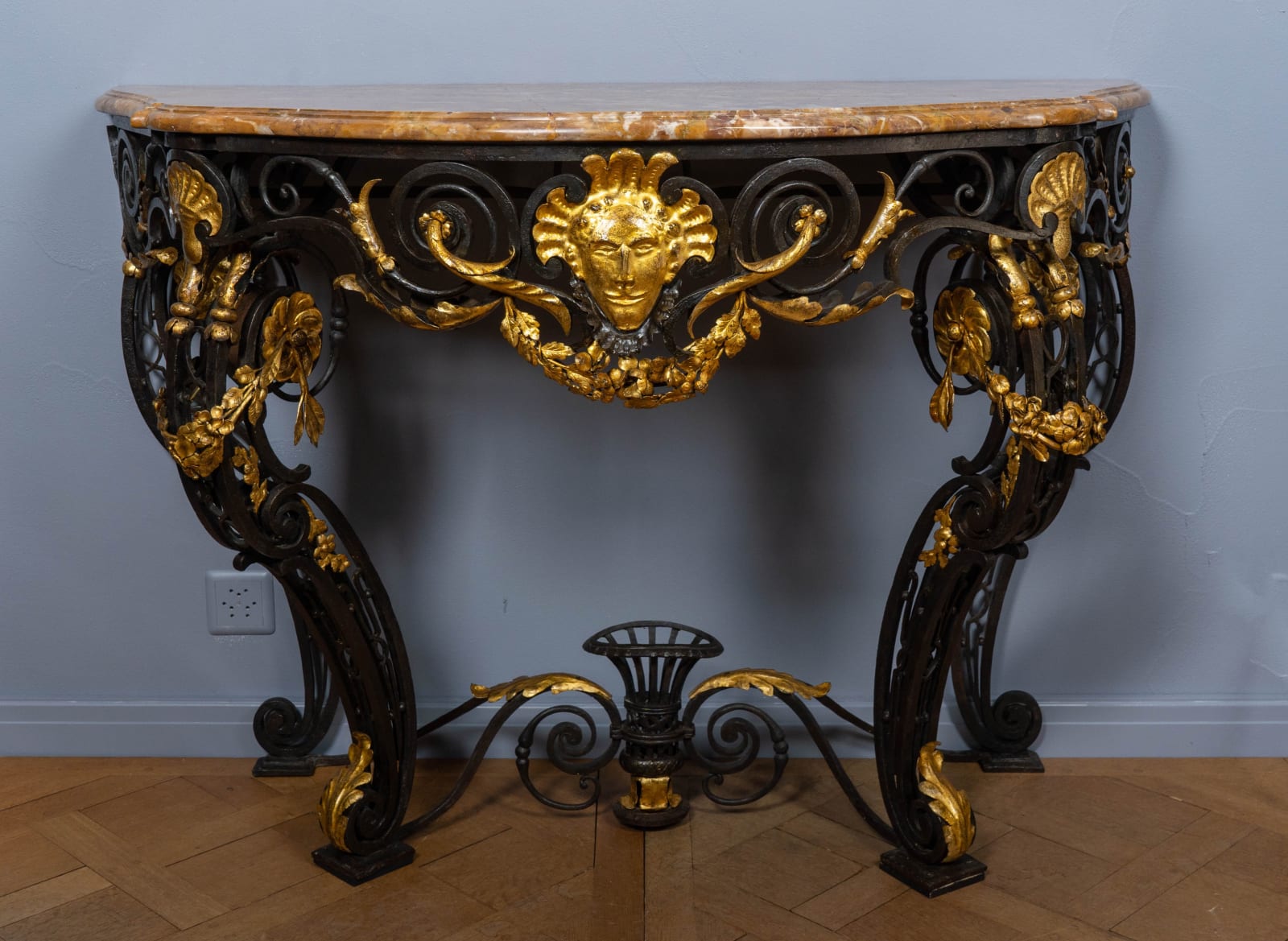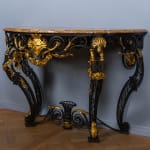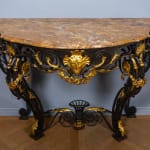A LOUIS XV WROUGHT IRON, PARCEL GILT AND SIENNA MARBLE CONSOLE TABLE, Provence, most probably Comtat Venaissin, date circa 1740
Height: 88 cm, width 126 cm.
Further images
A rare and very handsome Louis XV wrought iron, parcel gilt and Sienna marble console table, the moulded shaped Sienna marble top above a conformingly shaped frieze centred by a distinctive gilt male mask issuing from shell motifs, above a foliate and floral garland flanked by scrolls and further foliate sprays that are linked to the four supporting open-work serpentine legs, adorned with shellwork and floral garlands that suspend from rosettes mounted to the upper sides of the legs, the legs terminated by scrolled foliate-wrapped feet on square pads and joined by a scrolling stretcher, centred by an open-work basket
Height: 88 cm, width 126 cm.
This rare and highly exuberant Rococo console table or console d’apparat is typical of a type of ironwork that was associated with Provence, in southern France and particularly works made in Comtat Venaissin, of which similar examples are illustrated in Alain Renner’s book, “Mobilier de Métal de l’Ancien Régime à la Restauration”, 2009. Inspired by similar pieces made by the ébénistes of gilt carved wood, wrought iron consoles d’apparat emerged as ambitious creations made by artisans that belonged to the guild of the serruriers-ferroniers, who were more commonly used to making works that complemented architectural schemes.
The serruriers-ferroniers drew from the language of architecture; they were also inspired by designs by the ornamentistes such as Gabriel Huquier (1695–1772), whose “Nouveau Livre de Serrurerie” included similar designs for consoles, as we see here. The serruriers-ferroniers managed to interpret the Rococo style and its various motifs by forging the iron into a new expression, resulting in what was described as a “stylisation du style”, as noted in an article in “Connaissance des Arts”, 1957, “A la Recherche des Meubles de Fer du XVIIIe Siècle Français.” The creation of such pieces made from a robust and hard, yet characterful metal was an ancient process in which the iron was heated at extreme temperature. The white-hot metal was then beaten and shaped while the sheet metal was pushed onto sculptured dies, then chiselled and finally gilded. The two metals were then joined together by means of screws, rivets and wedges.
When polished, painted, gilt, silvered or applied with repoussé tole, wrought iron takes on a new vitality, full of warmth and richness that could rival works made of carved wood adorned with gilt bronze mounts. Furthermore, wrought iron furnishings provided a durability that wood was unable to offer. This material, when used in furniture, therefore became a sophisticated and rare component of luxurious French interiors from the early Louis XV period onwards. In addition, the physical strength of the wrought iron led to a preference for consoles fixed to the wall, playing with the contrast of the weight of the marble and the lightness of the open-work design, a feature that carved giltwood was rarely able to achieve.
The technique was particularly successful in southern France, namely in Provence and the region around Avignon and Marseille, where the grand townhouses were filled with examples of the technique and the imagination from the local serruriers of the eighteenth century. This is seen in staircases, balconies, and particularly in the many churches, from communion tables, altar rails and canopies, or in simple ornamental motifs. Only a small number of consoles d’apparat such as the present example, have survived. It was almost certainly made in Provence and more specifically at Comtat Venaissin, since the combination of the linear and graphic quality of design, compares with the architectural decoration from this region. Other distinctive characteristics include the stylised shell and mask head motifs, the pronounced S-shaped legs as well as the integral open-work basket adorning the stretcher below.





